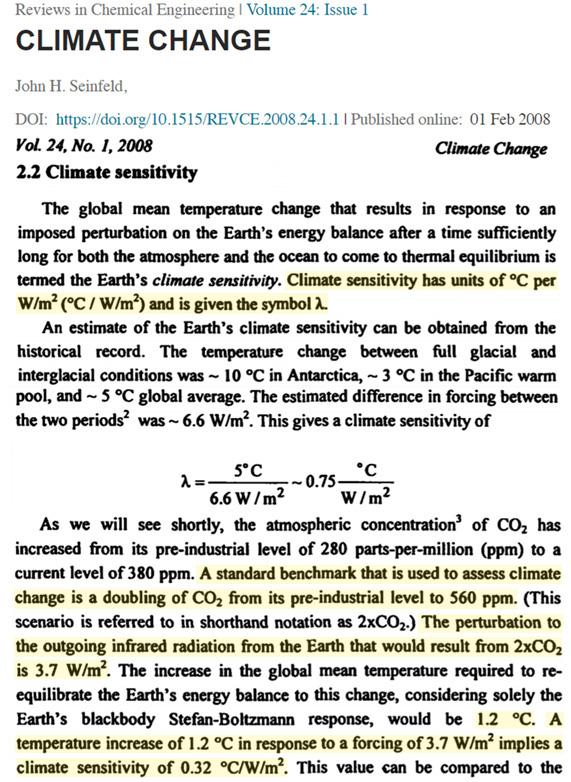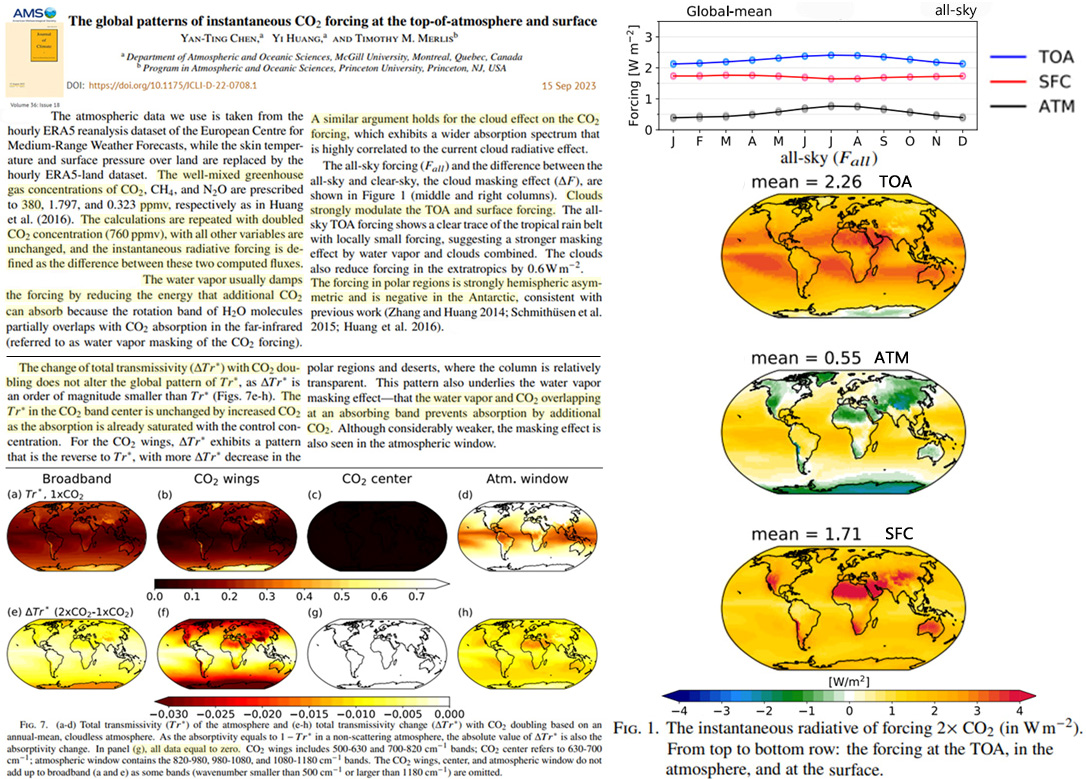Doubling the 2005 CO2 concentration (380 ppm) to 760 ppm only produces a globally-averaged 2.26 W/m² perturbation at the top of the atmosphere (TOA). This doubled-CO2 forcing is close to 0 W/m² for large portions of the globe – including below 0 W/m² for Antarctica.
The IPCC claims doubling CO2 produces a 3.7 W/m² TOA forcing, which is a 1.2°C direct (no feedback) temperature differential using the IPCC’s 0.32°C per 1 W/m² formula (Seinfeld, 2008).

Image Source: Seinfeld, 2008
A new study (Chen et al., 2023) published in Journal of Climate assesses doubling CO2 from 380 to 760 ppm only yields 2.26 W/m², 1.71 W/m², and 0.55 W/m² forcing at the TOA, surface, and troposphere, respectively. These forcing values represent 0.72°C, 0.55°C, and 0.18°C temperature differentials, respectively (0.32°C/W/m²).
The global mean surface temperature forcing for doubled CO2, 0.55°C, would by itself appear to already cast doubt on claims that all or nearly all of the post-1850 >1°C warming could have been driven by anthropogenic CO2 forcing.
Image Source: Chen et al., 2023
The 2.26 W/m² globally averaged TOA forcing identified in this paper is 39% lower than the IPCC’s globally-averaged estimate (3.7 W/m²).
CO2 forcing is identified as highly variable and latitudinally dependent. At some locations, such as over Antarctica, doubled CO2 TOA forcing is negative, or below 0 W/m².
“The [doubled CO2] forcing in polar regions is strongly hemispheric asymmetric and is negative in the Antarctic.”
This means that, as CO2 increases, its impact actually cools Antarctica. This contradicts the IPCC claim that CO2 climate sensitivity is amplified at the poles. It also undermines the alarmist claim that Antarctic ice melt (and consequent catastrophic sea level rise) is driven by CO2.
Chen and colleagues also report that CO2 has no effect on atmospheric transmissivity due to (a) absorption saturation (CO2 can have no effect beyond a pre-industrial concentration), and because (b) water vapor and cloud forcing overlap and thus dominate absorption in CO2’s band.
“[Transmissivity] in the CO2 band center is unchanged by increased CO2 as the absorption is already saturated…”
“[T]he water vapor and CO2 overlapping at an absorbing band prevents absorption by additional CO2.”
Finally, water vapor serves to “dampen” the warming effect of increased CO2, which calls into question the IPCC’s water vapor “positive feedback” claims.
“The water vapor usually damps the [doubled CO2] forcing by reducing the energy additional CO2 can absorb.”
Because this is a mainstream study published in a prestigious climate-focused journal, perhaps it may not be as readily dismissed by gatekeepers of the anthropogenic global warming (AGW) paradigm.





[…] Related: New Journal of Climate Study Reduces Doubled CO2 Climate Sensitivity By 40%, To 0.72°C […]
[…] From the NoTricksZone […]
[…] From the NoTricksZone […]
[…] From the NoTricksZone […]
[…] From the NoTricksZone […]
[…] From the NoTricksZone […]
[…] From the NoTricksZone […]
[…] Fonte : No Tricks Zone […]
[…] Fonte : No Tricks Zone […]
[…] main paper is behind a paywall but an excellent summary of its contents is provided by the science blog No Tricks Zone. The science is complex with the ‘Abstract’ […]
[…] New Journal of Climate Study Reduces Doubled CO2 Climate Sensitivity By 40%, To 0.72°C […]
[…] is negative in the Antarctic,” write the scientists. The main paper is behind a paywall but an excellent summary of its contents is provided by the science blog No Tricks Zone. The science is complex with the ‘Abstract’ […]
[…] principale è protetto da un paywall, ma un eccellente riassunto dei suoi contenuti è fornito dal blog scientifico No Tricks Zone. La scienza è complessa e […]
[…] Sources: No Tricks Zone […]
[…] main paper is behind a paywall but an excellent summary of its contents is provided by the science blog No Tricks […]
[…] principală se află în spatele unui paywall, dar un rezumat excelent al conținutului său este oferit de blogul de știință Zona fără […]